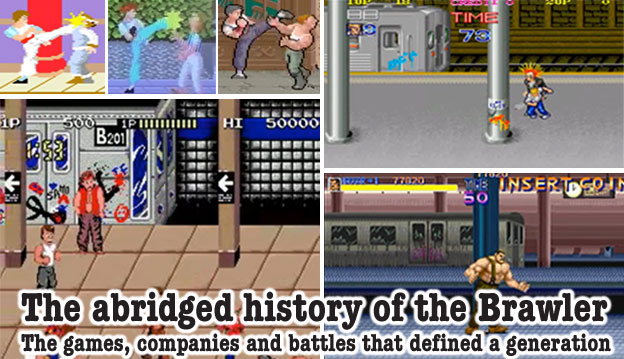
The games featured today were the best examples of how the brawler was shaping the game industry and creating sub-genres in its wake. 1989 was the year that showed it was not simply enough to follow the trend, studios had to innovate and change the genre in order to keep the momentum going. The first title was a sort of high water mark for the brawling sub-genre better known as the hack-and-slash.
Golden Axe developed by Sega was a sword and sorcery take on the brawler. It featured three characters, a barbarian like warrior known as Axe Battler, a dwarf named Gilius Thunderhead and a female warrior named Tyris Flare. All three fought with weapons instead of their bare hands across a medieval fantasy setting. They could take down rogues, bandits and monsters. In several portions the characters could even mount dragon-like creatures and burn down opponents. The trio of fighters were set to defeat a barbarian lord named Death Adder (which always was a cool name) before he could claim the Golden Axe and the kingdom that followed it.
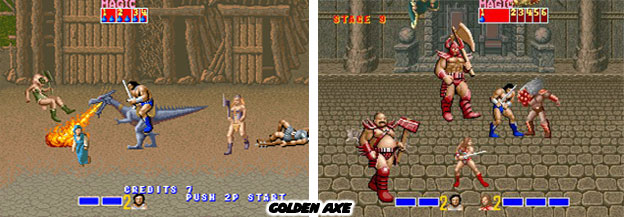
The game was important to the history of the brawler for the design and magic system that went along with it. Although it was infamous for a sound bite or two they ripped off of the movie Conan the Barbarian. The characters were fun but for the adolescent boys playing, the warrior Tyris was the memorable one. A perfect tan, a toned figure and a tiny white bikini weren’t quite the things people thought of as suitable for a warrior until Tyris came along. Tyris also sported the most powerful magic attacks in the game making her a practical choice and not just a sex object.
The fantasy themes worked well for the genre but were cemented by the exotic locations featured on the travels to find Death Adder. One level, which appeared like an island actually took place atop a giant sea turtle as it moved from port to port. Another branching path was set on the back of a giant eagle. Branching paths was a new feature in video games and Golden Axe was among the first, if not the first arcade title to use them. Incorporating a tremendous sense of scale had not been done in any previous brawler. The magic system itself was completely unique among brawlers. Players collected magic vials by hitting tiny thieves. Each level of magic required a set amount of vials. Once the player had collected them they could activate the magic at any time. The more vials required to activate a spell then the more damage it did to opponents. Players learned to save a magic attack for when they were surrounded by opponents or the final boss himself.
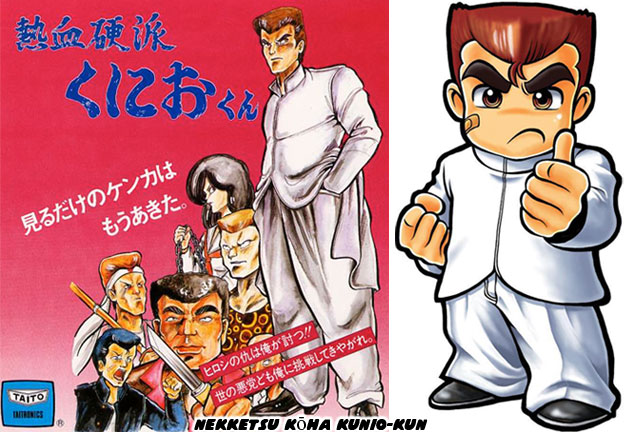
By this point the industry was clearly interested in the brawler and they were trying to bring the experience to home systems. Technos released a variation of the brawler with a Japanese High School theme titled Downtown Nekketsu Monogata. It was set in the same continuity as the arcade title Nekketsu Kōha Kunio-kun. For a while Technos actually had Kunio-kun act as a mascot. When that game came out for the Nintendo Entertainment System in North America we knew it better as River City Ransom. The limited processing power, color palette and memory of the NES meant that there was no way that the 8-bit console would be able to match anything the arcade had.
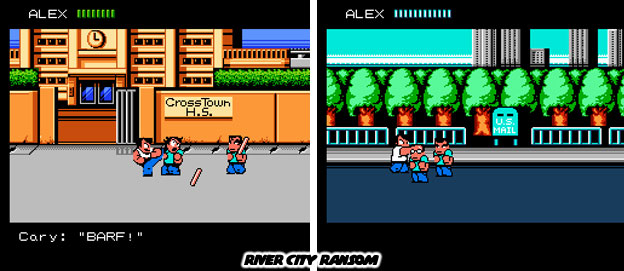
Technos succeeded in creating a memorable brawling experience by creating small stylized figures out of the Japanese high school characters. The smaller figures required less details and animations and the memory saved on limiting the detail on each character meant that more rivals could be drawn on screen by the processor. To keep the NES from being overworked the environment was limited to a strict, flat battleground while still allowing for backgrounds to change and show that characters were advancing through the city. In the end it was a pocket version of the brawler and proof that consoles were capable of carving their own niche with the genre.
With that said Konami was going to point out how the arcade brawler could get away with things not allowed by Nintendo’s policies which were a form of game censorship. In the arcade they released Crime Fighters. It was a large 4-player cabinet featuring generic characters wearing white shirts and four different colored pants. Talk about taking the quick road to character design! The game was notable for a few reasons. The designers created large, detailed environments for the four players to fight in an around. The characters were smaller than those featured in other brawlers but proportional unlike the River City Ransom figures.
The game pandered to just about every adolescent boy’s fantasy. It was a cool version of New York with plenty of brightly colored graffiti covering the walls and lots of fighting. It was extremely violent as well, more so than even Double Dragon. Rivals could knee the player in the groin players could hit opponents with lead pipes and even use a handgun, which was against the code of fair fighting for most brawlers. There was also a bit of sex appeal with a lot of cleavage shown in a billboard early on in the game, not to mention that rival female gang members were dressed like dominatrix’s and used whips on the players. Crime Fighters would never have been released on a Nintendo console without some serious retooling.
The game itself was fun but very difficult. Every credit gave players a set amount of health and that health counted down slowly. Taking damage from opponents caused the energy to drain faster. Thankfully some of the damage could be recovered at the end of the level based on how many opponents were defeated. That was of course if the player managed to beat the boss characters. The bosses were larger variations on the gang members, each boss having a gimmick like wielding a chainsaw or fighting with wrestling moves.
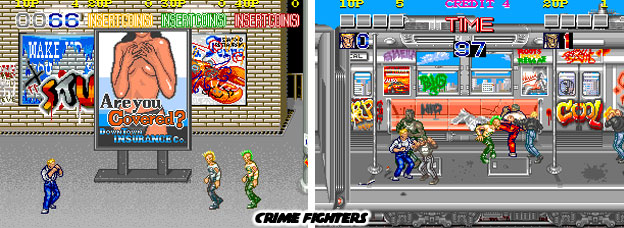
The hardest part of the game was the end in which all of the bosses had to be defeated in a battle royal. Konami wasn’t mincing things, they wanted one of the most difficult and quarter-hungry games of all-time. It did fairly well in arcades, however there was another brawler released that same year which took the lion’s share of profits.
Final Fight by Capcom was the heir apparent to Double Dragon. In fact the producers went into the project trying to dethrone the game. For the most part it was mission accomplished. Visually the game was a great leap ahead of the Taito brawler. The sprites were larger, more detailed and better animated. The designs of the heroes and rival Mad Gear gang members would become brawling archetypes. For players there was a large and powerful character that moved slowly but could deal great damage with his wrestling moves. There was also a smaller martial artist that struck very quickly and whose quick punches and kicks could stun opponents approaching from any direction. Then there was a character in the middle that had strength and speed at his disposal. For the gang members there were character types that mirrored the heroes. The world that they inhabited, a certain Metro City, would become part of Street Fighter canon.
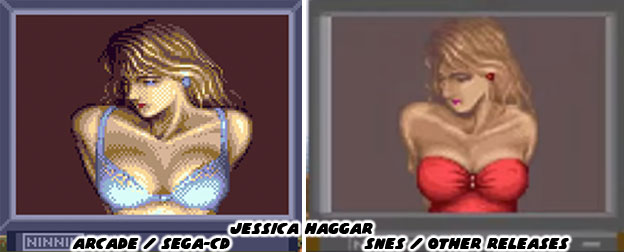
The plot was familiar, a girl was kidnapped and a team had to come to her rescue. Arcade players were treated to a shot of Jessica Haggar in her bra tied to a chair. This bit of skin already made the game more mature than other brawlers. This show would be toned down and even removed in future revisions and home versions. It turned out that she was the daughter of Mike Haggar the mayor of Metro City. The former champion pro wrestler recruits Jessica’s fiancé Cody and his martial arts trainer Guy to go into battle. The rest of the game was a lesson in flawless design and execution.
Players were taken through the boroughs of Metro City on the way to rescue Jessica from the crime lord Belger. The Mad Gear gang members hanging out, seemingly every few feet, waiting for their chance to take on the advancing heroes. Along the way new boss characters were introduced. Sodom, Rolento and Andore, that would become legendary in future Capcom fighting games. The game had the right amount of difficulty and challenge. Patient players could pick off most opponents and use all the time available to them to clear each stage with a minimal amount of health lost. Those that wanted to go all out and have all three players on screen at once for some mayhem could do the same at the risk of wasting plenty of quarters. Those that went full tilt into the game experienced the best that the brawler had to offer.

The arcade was the original social gaming experience. Players did not have the luxury of being connected to a network and having players across the country or around the world be able to drop into the action. If a player needed help clearing a stage then a friend or family member would have to be standing with them, fighting the good fight. Ask any player that remembers clearing a fighting game how much fun was had when the battle was a shared experience. Memories were made and bonds grew stronger when players could say that they fought from beginning to end with a good friend. It was that way for my brother and our friends when we visited the Cal State Long Beach campus while still in high school.
We were on a school field trip and Final Fight had been released earlier. A brand new cabinet was waiting in the campus arcade. Instead of enjoying our lunch my brother and friends decided we were going to beat the game and earn the bragging rights among the other gamers at school. The risk of not eating was not as big as missing the bus back to school. We were determined that nothing was going to stop us and played through level after level. Frantically running back and forth between the change machine and the cabinet to keep us engaged when the lives started running out. Defeating wave after wave of the relentless Mad Gear gang members with a combination of shoulder throws, jumping piledrivers and spinning back kicks. Surviving the cheap shots by bosses and their countless minions. Getting a small group of classmates gathered around the machine rooting us on and at long last kicking Belger out of a window and reuniting Cody with Jessica. Those memories would never be replaced in our collective consciousness. It was more than 20 years ago today yet the memories remain vivid as ever. Proof that gaming could have a profound impact on our lives. Yet the brawler would not be done shaping our gaming tastes The new decade would see the genres pulled in many different directions all at once. I hope to see you back for the next blog which will look at how the 1990s saw some of the defining moments in all of gaming. As always if you enjoyed this blog and would like to sponsor me please visit my Patreon page and consider donating each month, even as little as $1 would help make better blogs and even podcasts!

Golden Axe the thrill of terrozing elves trying to steal from you in your sleep. Final Fight Sega CD ARCADE PERFECT (atleast that's how I remember it)
ReplyDelete